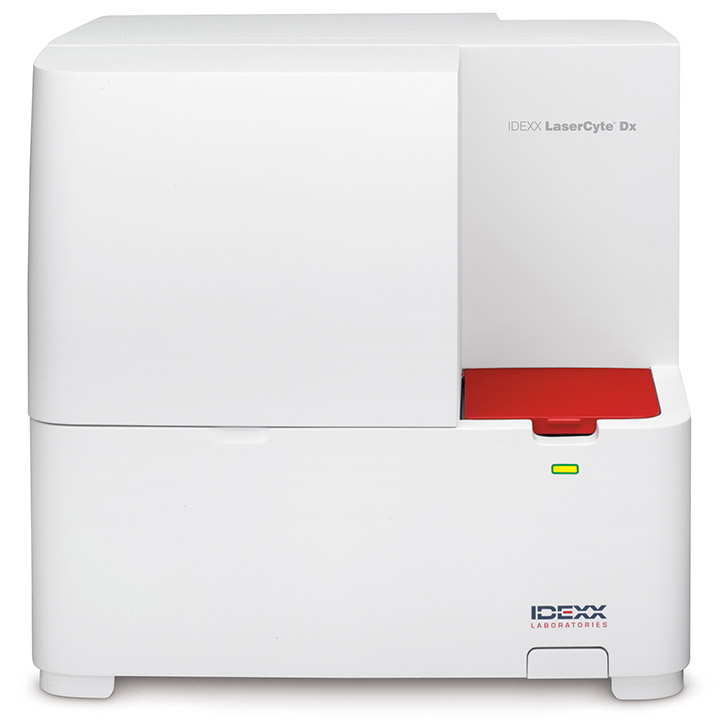
LaserCyte Dx Hematology Analyzer
Comprehensive real-time results that help you provide a higher standard of care
- The LaserCyte Dx Hematology Analyzer offers you the most accurate, real-time, comprehensive hematology information in-house in minutes.
- Make more informed decisions more quickly and share results with clients during the patient visit.
The LaserCyte Dx analyzer connects to the IDEXX VetLab Station Laboratory Information Management System to provide:
- All your diagnostic information in one comprehensive patient report
- Access to IDEXX SmartService™ Solutions: remote troubleshooting for your IDEXX VetLab analyzers that saves time and helps keep your laboratory running smoothly
Benefits
Accurate, comprehensive hematology results in real time
Benefits of the LaserCyte Dx Hematology Analyzer include:
-
Reference laboratory-quality complete blood counts (CBCs).
-
A true five-part white blood cell differential for a full analysis of multiple characteristics on each white blood cell and an accurate interpretation of all five white blood cell types.
-
Absolute reticulocyte count to help identify the underlying cause of anemias.
-
No daily maintenance.
-
qualiBeads are analyzed with the sample during each run to ensure the quality of the run as well as across runs to ensure the analyzer remains properly standardized.
-
Single-sample reagents and onboard mixing system reduces user training requirements—sample aspiration is totally automated.
-
Early platelet aggregates are broken up for accurate platelet counts.
-
Fully validated species menu and 24 hematology parameters.
-
Closed-tube sample processing means no sample preparation and no contamination.
Technology
Laser Flow Cytometry
The LaserCyte Dx Hematology Analyzer uses reference laboratory technology to analyze blood samples. The analyzer focuses a laser beam on each individual cell and quantifies the scatter of light on four separate detectors.
Simultaneously, the analyzer measures the amount of time it takes a cell to travel through the laser beam. This cell travel time is referred to as the “time of flight” and it provides data on the diameter of the cell.
Example:
Think of a flashlight as an analogy for the laser. Passing a golf ball in front of the light is quicker than passing a basketball through the same light.
While the time of flight, or cellular diameter, is being measured, four other detectors are measuring the quantity of light bouncing off the ball.
The dimpled design of a golf ball will refract light differently than the seamed design of a basketball. Therefore, in this analogy, the golf ball would be classified as a different “cell” from the basketball.
The four detectors quantify the scatter of light from each cell to measure size, complexity, granularity and light absorption—the same qualities a pathologist would examine when looking at a blood film.
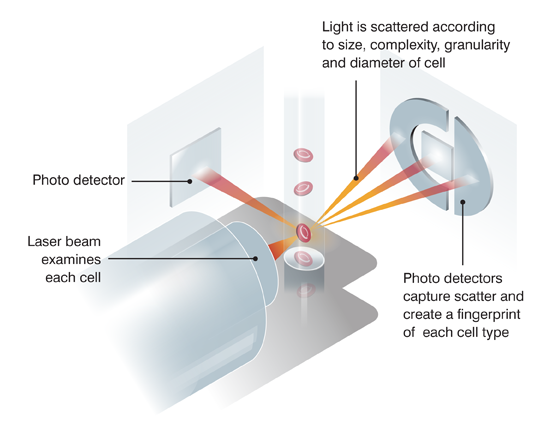
The LaserCyte Dx analyzer provides the data needed for a more complete diagnosis because it can:
- Analyze red blood cells
- Identify the reticulocytes and generate an absolute reticulocyte count
- Identify all five types of white blood cells
Advantages of laser flow cytometry
- Because a laser flow cytometry-based analyzer evaluates multiple characteristics (nuclear and cytoplasmic material) of red blood cells, white blood cells and platelets, it produces more accurate and reliable counts than other systems.
- Clumped platelets can be detected and flagged.
- Large platelets (frequently encountered in cats) can be distinguished from erythrocytes due to difference in the scatter of light caused by the platelet granules.
- Laser flow cytometry-based analyzers are able to rapidly count large numbers (>200,000) of erythrocytes, which are needed to produce accurate and repeatable reticulocyte counts.
Accuracy Verified
To ensure the trusted hematology results you need, we partnered with Purdue University, the University of Florida, Tufts University and Michigan State University to compare the performance of the LaserCyte Dx Analyzer to the ProCyte Dx Hematology Analyzer.
The following graphs compare the results obtained using two LaserCyte Dx analyzers and a ProCyte Dx analyzer at the University of Florida. The data includes canine, feline and equine samples (totaling 100 of each species split across the two LaserCyte Dx analyzers). These results indicate good correlation between the LaserCyte Dx and the ProCyte Dx for canine, feline and equine samples.1
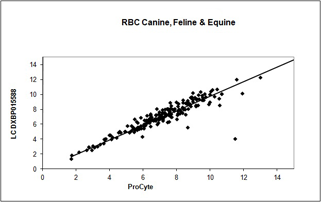
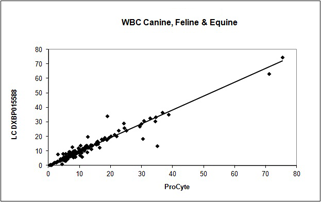
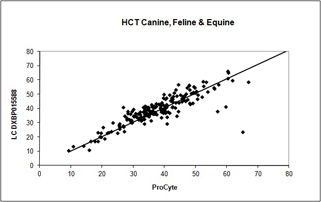
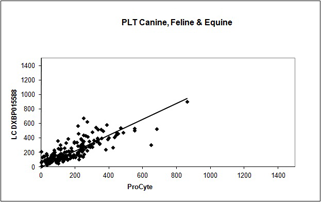
View the LaserCyte Dx Analyzer: Case Study Book and Technical Guide (PDF) for detailed information on the LaserCyte Dx analyzer, including case studies, dot plots, and laser flow cytometry technology.
Specifications
|
Parameters (24) |
Hct, RBC, Hgb, MCV, MCH, MCHC, RDW, reticulocytes (absolute number and percentage), WBC, neutrophils (number and percentage), lymphocytes (number and percentage), monocytes (number and percentage), eosinophils (number and percentage), basophils (number and percentage) and platelets (number, MPV, PDW and PCT) |
|
Units |
Conventional or SI units |
|
Sample Size |
95 µL of sample with EDTA anticoagulant is used per evaluation (500 µL of sample in a 13 mm x 74 mm VetCollect Tube is required) |
|
Time to Results |
The LaserCyte Dx analyzer will return resutls in approximately 10 minutes. |
|
Reagents |
The LaserCyte Dx CBC5R Test Kit includes 50 CBC5R tubes, 50 VetCollect 1-mL draw sample collection tubes, one tube of enzymatic wash solution, one discard tube and two bottles of sheath reagent. |
|
Calibration |
Performed at IDEXX. Lot-specific reagent information is bar-coded onto each consumable tube. |
|
Internal Standard |
Each CBC5R tube has a set number of qualiBeads®. qualiBeads are known particles with specific characteristics that are used by the analyzer as an internal standard to verify pipetting accuracy and laser performance. |
|
Sample Flow Cell |
250-micron quartz cuvette using focused-flow hydrodynamics to create a single-cell stream |
|
Operating Temperature |
Instrument 15º–27ºC (60º–80ºF) |
|
Dimensions |
LaserCyte Dx analyzer: width x depth x height = 34 x 36 x 33 cm |
|
Net Weight |
LaserCyte Dx analyzer: 8 kg (17 lb) |
Test Menu
LaserCyte Dx Analyzer Parameters
The LaserCyte Dx Hematology Analyzer offers a full menu of hematology parameters and prints all your IDEXX VetLab in-house analyzer results in one comprehensive report. The report provides a complete picture of your patient's health status and facilitates face-to-face communication with clients.
| Parameter | Description | |
| HCT (hematocrit) |
With every report |
|
| RBC (red blood cell count) |
|
|
| HGB (hemoglobin) | With every report | |
| RETIC (reticulocyte count and percentage of reticulocytes) | Reticulocytes are essential and the gold standard for characterizing if an anemia is regenerative or nonregenerative. | |
| MCV (mean cell volume) |
|
|
| RDW (red blood cell distribution width) |
|
|
|
MCHC (mean cell hemoglobin concentration) |
With every report |
|
|
MCH (mean cell hemoglobin) |
With every report | |
| PLT (platelet count) | The LaserCyte Dx analyzer’s laser flow cytometry offers a much more accurate platelet count than impedance-only counters | |
| MPV, PDW, PCT (mean platelet volume, platelet distribution width, platelet hematocrit) | Aid in the characterization of a platelet abnormality (such as presence or absence of a bone marrow response to a peripheral demand for platelets) | |
| WBC (white blood cell count) | With every report | |
| Monocytes and Lymphocytes (% and #) |
|
|
| Neutrophils (% and #) | Important in identifying certain types of inflammatory disease and their severity, as well as following the progression or regression of inflammation | |
| Eosinophils (% and #) | Important in identifying systemic hypersensitivity, which can be caused by heartworm, flea bite dermatitis, feline asthma, allergic gastroenteritis and more | |
| Basophils (% and #) | May be helpful in identifying systemic hypersensitivity, as well as acute allergic reactions |
How To / Resources
Unprecedented ease-of-use
Run a test in just three easy steps
- Place the sample and CBC5R tubes in the LaserCyte Dx analyzer.
- Enter the client and patient information on the IDEXX VetLab Station.
- Tap the Run button and walk away.
That's it!
Results are ready in just minutes for next steps and sharing with clients during the patient visit.
Resource List
LaserCyte Dx Hematology Analyzer: Case Study Book and Technical Guide
Educational Partner
IDEXX is an Educational Partner of the American Association of Equine Practitioners

IDEXX Learning Center
Reference
1. Data on file at IDEXX Laboratories, Inc. Westbrook, Maine USA.